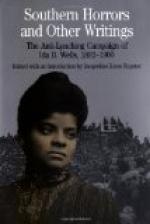Frank Weems of Chattanooga who was not lynched in May only because the prominent citizens became his body guard until the doors of the penitentiary closed on him, had letters in his pocket from the white woman in the case, making the appointment with him. Edward Coy who was burned alive in Texarkana, January 1, 1892, died protesting his innocence. Investigation since as given by the Bystander in the Chicago Inter Ocean, October 1, proves:
1. The woman who was paraded as a
victim of violence was of bad
character; her husband was a drunkard
and a gambler.
2. She was publicly reported and
generally known to have been criminally
intimate with Coy for more than a year
previous.
3. She was compelled by threats,
if not by violence, to make the charge
against the victim.
4. When she came to apply the match
Coy asked her if she would burn him
after they had “been sweethearting”
so long.
5. A large majority of the “superior”
white men prominent in the affair
are the reputed fathers of mulatto children.
These are not pleasant facts, but they are illustrative of the vital phase of the so-called race question, which should properly be designated an earnest inquiry as to the best methods by which religion, science, law and political power may be employed to excuse injustice, barbarity and crime done to a people because of race and color. There can be no possible belief that these people were inspired by any consuming zeal to vindicate God’s law against miscegnationists of the most practical sort. The woman was a willing partner in the victim’s guilt, and being of the “superior” race must naturally have been more guilty.
In Natchez, Miss., Mrs. Marshall, one of the creme de la creme of the city, created a tremendous sensation several years ago. She has a black coachman who was married, and had been in her employ several years. During this time she gave birth to a child whose color was remarked, but traced to some brunette ancestor, and one of the fashionable dames of the city was its godmother. Mrs. Marshall’s social position was unquestioned, and wealth showered every dainty on this child which was idolized with its brothers and sisters by its white papa. In course of time another child appeared on the scene, but it was unmistakably dark. All were alarmed, and “rush of blood, strangulation” were the conjectures, but the doctor, when asked the cause, grimly told them it was a Negro child. There was a family conclave, the coachman heard of it and leaving his own family went West, and has never returned. As soon as Mrs. Marshall was able to travel she was sent away in deep disgrace. Her husband died within the year of a broken heart.
Ebenzer Fowler, the wealthiest colored man in Issaquena County, Miss., was shot down on the street in Mayersville, January 30, 1885, just before dark by an armed body of white men who filled his body with bullets. They charged him with writing a note to a white woman of the place, which they intercepted and which proved there was an intimacy existing between them.




